Diablo IV Review (PS5) – Evil’s Flame Reignited
With the controversial release of Diablo: Immortal last year courting a whole range of criticism, the Diablo series was standing on less than holy ground. The series needed a win, and then some. Stepping forth from the underworld was Diablo IV, a title that promised a huge open world and a return to the “true” demonic form of old.
Diablo IV’s beta eased many of the concerns that had befallen the series, thanks to its generous content offering an insight into evil’s hordes yet to be faced. We certainly enjoyed it, and our beta impressions reignited the hope for an exciting ARPG once more.
Hosting a new villain on the rise in Lilith, a massive world to battle demons forever more and a host of next-gen upgrades to make use of, does Diablo IV reclaim its throne in the world of Sanctuary? Or does it succumb to evil’s influence, falling ever further into the depths of hell itself? It’s time to find out, Horadrim.
Evil Breeds Evil
In the run up to Diablo IV’s release, the darker, more violent and desolate tone of for this entry was being heavily advertised. The story is unafraid of descending down into the depths of evil to explore its themes and characters. The central antagonist, Lilith, is a powerful, corrupting influencer. Bending people’s minds, scheming above Lesser and Prime Evils alike. She’s a compelling foe to pursue and watching her story reveal itself over the 6 Acts is thoroughly intriguing.
Whether it be gruesome murders, horrific rituals or violent displays of power, the game is more than willing to match the idea of evil with the on-screen depiction. The broodier, ungodly tone creates a suffocating atmosphere over our hero’s pursuit of her and there are scenes the more squeamish will be rather uncomfortable with. However, this works in the game’s favour, matching up with its world-building and the sense of dire stakes owing to Lilith’s ultimate aims.
The campaign is lengthy, providing plenty of opportunity to flesh out the villains but also explore backstories around our main hero and their companions. Whether it be the history of Donan, the drunken isolation of Lorath or the inter-politics of Demons and Angels, Diablo IV has clearly had a lot of creative freedom to flesh out its wider cast. Not all of it lands as well as the primary story, with some trudging bits towards the middle of the Acts, but I was wrapped up in Donan’s history and arc or Innarius’ hubris and utter arrogant contempt of humanity.
There’s a big emphasis upon prophecy, destiny and the role of Demons, Angels and Horadrim. Humans are simply the pawns of the more powerful figures, again adding to that desperate sense of a world that is doomed. I enjoyed the story far more this time around than in 3, mainly for its willingness to plunge into the heart of darkness and embrace the decay. It’s not going to be the main draw for the vast majority of players, but the work put into this story to make it interesting and engaging has certainly paid off.
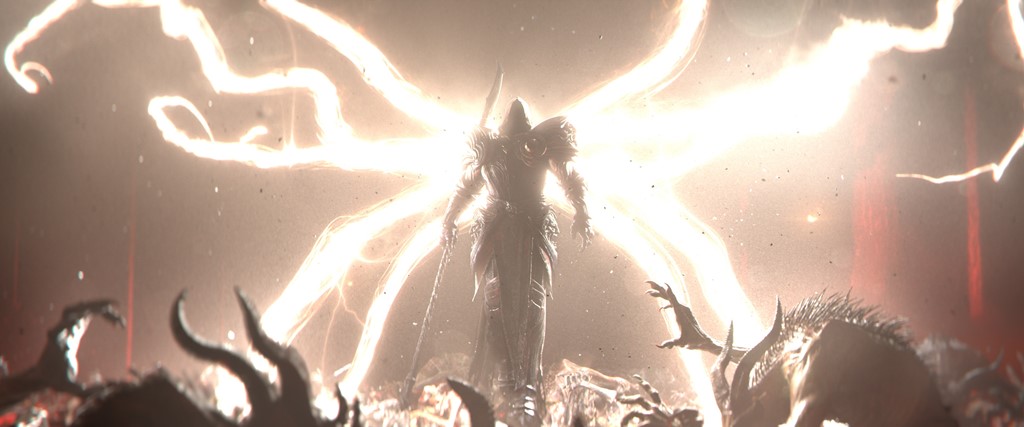
No Solace In Sanctuary
Diablo IV’s story once again takes place in the world of Sanctuary, as you chase Lilith through a massive interconnected landscape. Unlike previous entries in the series, this iteration is open-world instead of map or hub structured. Once you’ve completed the prologue and reached the first city of Kyovashad, you are set loose upon the land at large.
Split into 5 regions, each one sporting dozens of large, open zones, the sheer square-meter space of the map is enough to rival hell itself. Each area has its own set of story-related quests, over 40 side-quests, multiple dungeons to conquer, boss battles to overcome, shrines to uncover and towns to peruse. Not only that, but each region has its own style and theme behind it.
Fractured Peaks is a snowy, hilly region with caverns to traverse and large, imposing architecture to explore. Scogslen is damp, swampy and haunting, like the Dagobah of the Diablo universe. Kehjistan and Dry Steppes are more desert-like and Howezar is a mix of ideas. Locations, towns and cities feel well-realised and have an abundance of details to ensure they come to life as that very life is being snuffed out all around them.
Having a world so large and interconnected which is freely explorable from the start makes Diablo IV feel like a major upgrade from its predecessors. There’s no loading between zones or spaces (unless entering an interior location), with a balanced fast-travel system that encourages you to venture out without having to waste too much time running around. If there’s one element that had me excited and overawed at once, it was the size and scope of Sanctuary that’s been brought to realisation here.
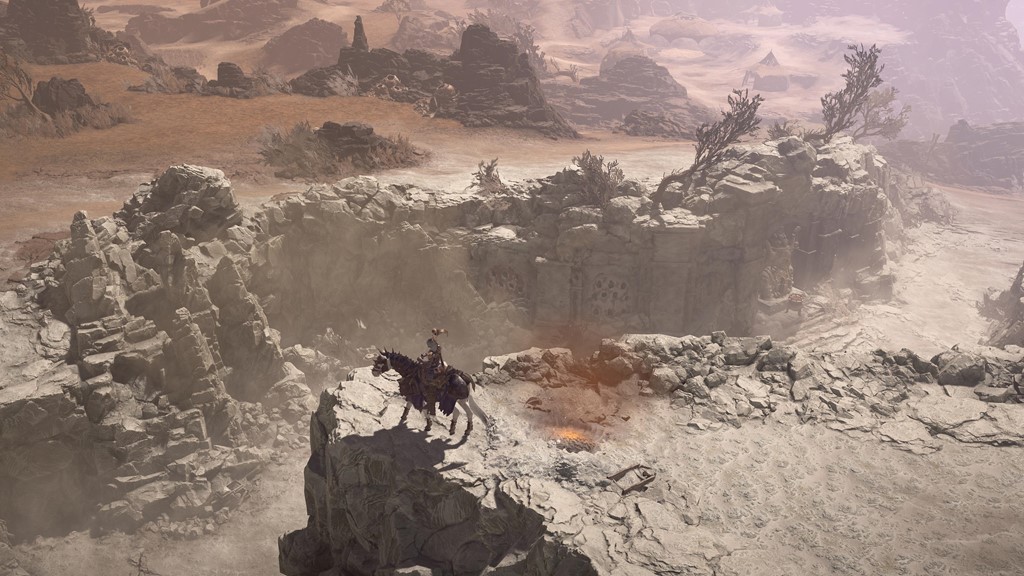
Just A Baal Of Destruction
If you were expecting to have a nice, casual stroll around Sanctuary this time around, well, I’d be querying if you’ve ever played a Diablo game before. Demons, undead, wild creatures, heretics, vampires, bandits and all manner of unholy abomination awaits you with eagerly baited fangs. Nowhere is safe outside of the towns and cities, making any journey rather perilous.
Combat in Diablo IV has been trimmed down for accessibility (on console anyway), allowing you to utilise the shoulder and face buttons for your attacks and specials. The addictive gameplay melody of this ARPG franchise has lost none of its perfectly tuned eloquence. Regardless of your class, you’ll be using basic attacks to build up your essence meter so that you can then unleash all manner of destructive powers.
Having tried out 3 of the classes in the beta, I settled on the Necromancer for my full campaign. With an army of skeleton minions and a troll at my side, I waged war with the demons of hell aplenty. Thanks to the ability to re-spec your character at any time (at the expense of some currency), you can freely mix and match your abilities, experimenting with different powers and builds.
For the majority of encounters, even a poorly optimised build will actually get you pretty far. Playing as a ranged or support-focused class however, you may struggle in boss battles or more challenging dungeon runs, particularly late-game. As an example, my first build meant I couldn’t create corpses to reanimate, leaving me in a horribly imbalanced war of attrition in one-to-one duels. After being made dead as an undead multiple times, I completely revamped my skills, with which I kicked that demon’s ass back into the fiery pits of Hades itself.
Diablo’s combat will become familiar and repetitive should you be willing to lull yourself into a comfortable build. The various options for skill customisation and how well you mix and match your specials with basic attacks will determine whether you have an angelic time of free-flowing slaughter or a hellish experience of mundane button-mashing.
Some will probably miss Diablo II’s ability to have tiers of powers equipped at once and a couple of elite types of enemies can be frustrating (I’ll never not hate ‘terrifying’ enemies, Mephisto would be proud), but given the breadth of the variety in enemy types and threats you’ll face, they’re a tiny aberration in an otherwise stellar gauntlet of Diablo’s army.
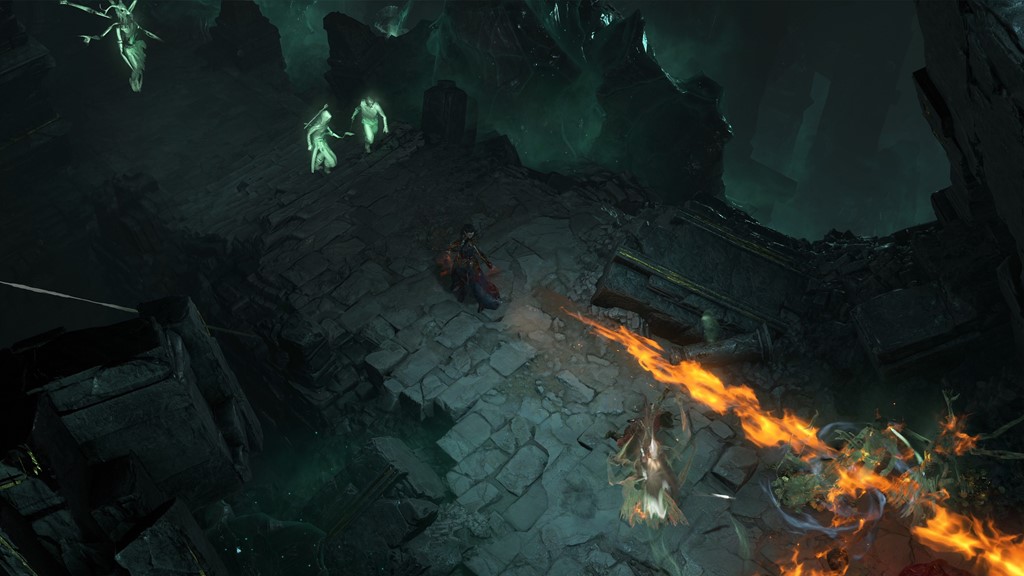
Embracing Exploration
While you absolutely could venture out onto the planes to deliver holy vengeance on the hordes of scoundrels just for the sake of it, there’s plenty to motivate your crusades. Side missions can vary from simple fetch quests to entire dungeon crawls, complete with mini-bosses and swarms of powerful enemies.
Even basic dungeons scattered around the map hold the promise of Aspects, powerful imprinting attributes that can be attached to weapons to improve and upgrade your skills. Every underground complex will have a sprawling network of tunnels, dead ends and looping paths to navigate, filled to the brim with treacherous foes.
Diablo IV, thankfully, rewards almost all of your endeavours across it’s content-rich map. Tiered loot returns and drops with the kind of abundance that’ll have you feeling like a leprechaun going over a rainbow. Dungeons inform you what character class the reward will benefit so you can selectively decide which you want or need to do. Every quest, found altar or new area rewards XP to level you up and hoover up more skill points to invest in powers.
This isn’t anything necessarily new or original, but Diablo IV seizes control of your entertainment desire like a lord of hell seizes souls. For the first 3 Acts you’re required to meekly walk everywhere you need to go, but after reaching a certain point you’ll be given control of a mount which makes exploring even more straightforward and efficient. I never thought I’d appreciate a horse so much in a video game since Roach.
I appreciate the balance struck by having you slowly traverse each location initially so you can fully embrace the world, before then giving you the means to travel all over the map in the blink of an eye.
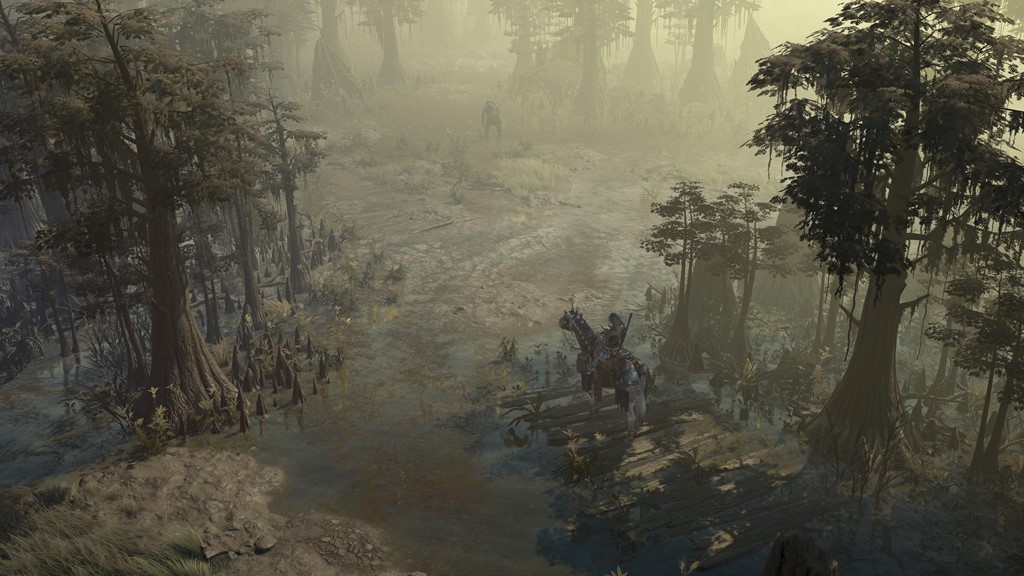
En-Duriel A World of Threats, and Opportunities
As well as your typical questing and dungeon-crawling, you’ll be able to engage in world events throughout Diablo IV’s map. One of the systems to see a big upgrade is your ability to interact with other players in the various towns across Sanctuary. Akin to Destiny’s seamless multiplayer mechanics, every other Horadrim embarking on their epic quest will appear in yours or someone else’s game.
You can emote with them (which you also use to finish some quests, strangely), trade and arrange coop sessions with ease. Furthermore, if you happen to be out in the world, they may randomly come to your aid or in my case, lead a frenzied pack of wolves straight to my location and disappear. Rather rude, but quite amusing.
Scattered around the landscape are smaller world events such as purifying an urn by killing enemies, or defending a poor townsfolk local by killing enemies, or satisfying spiritual pyres by… you know how by now. Alongside Legion events and world boss fights, there’s ample opportunity to team up with your fellow Rogues or Druids to take the fight to the lords of hell. These events offer the biggest draw for the long-term survivability of Diablo IV and can be quite the spectacle, making them excellent diversions.
The best part is you don’t even have to be sociable. All of this happens in-game, though the trade-off is the forever hated always online requirement. If stranger cooperative gameplay doesn’t take your fancy however, you can very easily squad up with your buddies, with the host’s world acting as the anchor. Loot is separate too so you don’t have to worry about someone like me stealing in for your well-earned goodies.
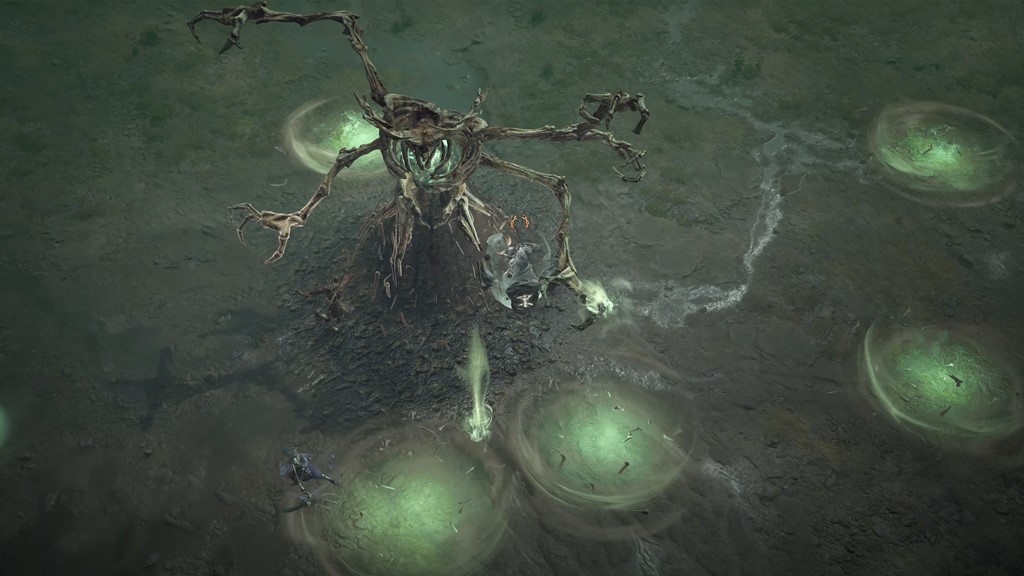
Diabolical Style
Now, I know that if you’ve played any ARPG – especially Diablo – before, you want to know how the customisation and progression systems are. Well, my demon-hunting friend, you’re in luck. Levelling up accrues skill points that are then invested in a linear-progressing branch system. From your basic attacks in the first cluster to your ultimate and powerful passive in the final one.
In each cluster, you can select which abilities you want to learn and then invest points into improving. There are a variety of active and passive boosts you can choose to shove your hard-earned gains into, but you’ll always be wondering what wondrous opportunities you’ve passed up in other powers. As I mentioned before, you can re-spec with relative ease, only spending money to reset points.
Which is fantastic if, like me, you’re prone to poor decision making in the excitement of an especially thrilling skill description. However, it does mean you can expect to see meta builds for each class become incredibly common amongst your travels. Aside from this, the opportunity to invest in each character’s abilities, their ‘special’ – like for example the Necromancer’s book of the dead for their undead army and your equipment attributes – can all radically change how you play and how much of a power trip Diablo IV can really be.
You can also transmogrify items to keep your preferred look without sacrificing stats. Every piece of equipment can be upgraded, have attributes attuned and be socketed with stat-boosting gems. It would be overwhelming, if it wasn’t so easily accessible within the various vendors. For newcomers, it probably will be a trial by fire of experimenting only to lose a precious Aspect you’ve come to hold dear or having to let go of your first OP legendary weapon, but that’s all part of the fun.
Hell isn’t all about fires and magma, it’s about letting go of your sword that grants you two extra skeleton mages as your newly-earned yellow sword has +50 DPS on it.
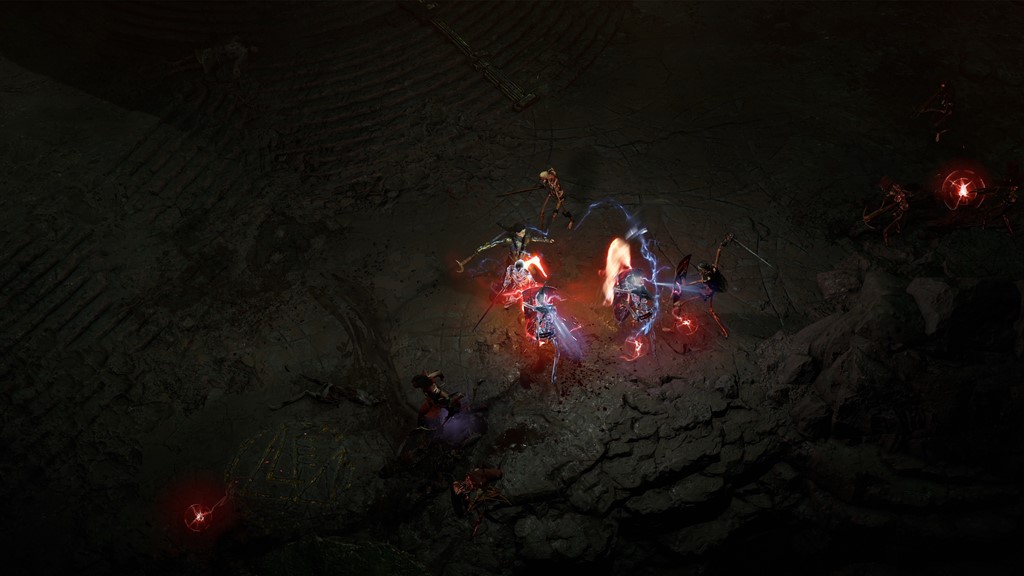
Grotesque Beauty
Diablo IV already impressed with its graphical fidelity and sumptuous environments in the beta and thankfully the full release continues to be inspired. There were so many moments where I gawked at the level of detail of a mountain face, recoiled at the vile bloody tendrils animating silkily in the background or admired a grand piece of architecture like an underground palace.
Diablo IV is a visual spectacle when it comes to building out an entire landscape. Not only that, but battle animations are flashy and satisfying. Watching as my Blood Novas draw the life force of dozens of enemies around me or sitting back to witness the carnage as my troll stampedes into a group of unsuspecting foes. Though, I did tire of the same interior locations – there’s only so many times I can traipse through the same cave network or prison block before it becomes tedious.
In-game character models do still have that stilted animation walk about them and their models can stick out as less impressive when compared with the rest of the package. But overall, Diablo IV is a beautiful, broody, atmospheric gem of a visual package. It probably has some of my favourite level design in an ARPG and the concept artists have done phenomenally to sell the vision of this world mired in darkness, gloom and evil’s iron grasp.
Performance wise, things were both holy and distinctly unholy in equal measure. For the most part, Diablo IV ran at a perfectly smooth framerate with next to no drops, even with crowds of enemies all animating at once. However, twice the game locked up on itself when I tried to fast travel out of an area, requiring a restart. Another frustrating moment came after defeating the final boss of Act 2, only for the game to not update the objective, therefore locking me in the arena, having to restart and doing the entire fight again.
More minor issues like the odd visual bug or the camera not making a structure transparent when it’s in the way of your view are annoying, but they’re rare. In a game this large and so packed full of content, these are more than forgivable. I just hope the crashes and objective tracker issues get resolved sooner rather than later.
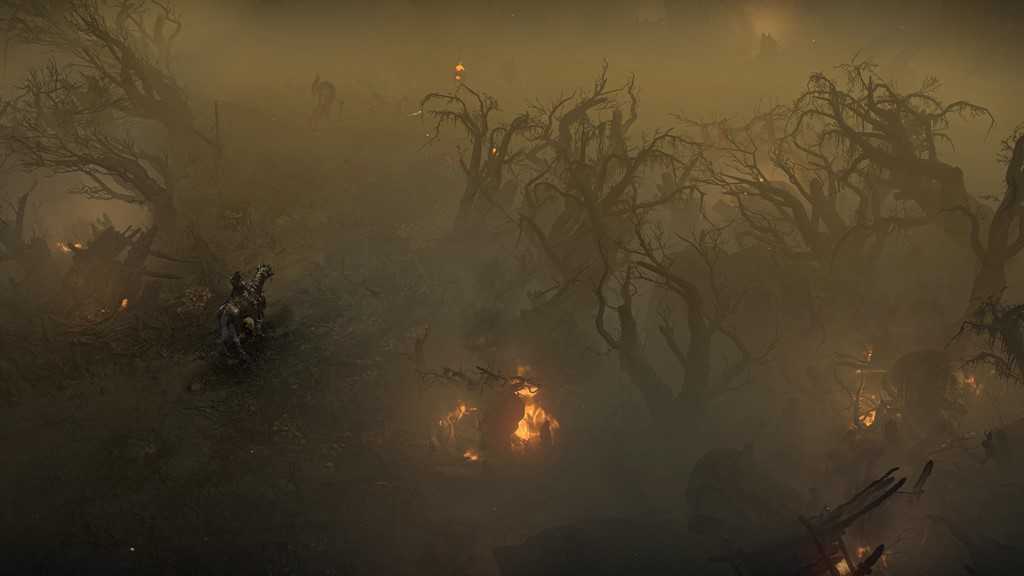
Lilith Ascends The Throne
When Diablo III released back in 2012, it found itself lurched into a quagmire thanks to the ill-received auction house and poor endgame offering. Through a lot of work and extra content, it managed to redeem itself, though never quite receiving the acclaim it may have deserved.
Diablo IV will have no such issues. This is a confident, grand expansion of a series that many – including myself – feared the worst for after the shambles of Diablo: Immortal. The rise of Lilith has proven a masterstroke, with a massive world oozing with content, a streamlined gameplay loop that maintains its depth and an engrossing class customisation system that incentivises experimentation and repeat playthroughs.
This isn’t just a return to form for the Diablo series. This is the distilling of decades worth of experience into a stellar ARPG that rises to the top of the genre. Live service as a term is normally one that fosters caution and reservations for me, yet I find myself only more excited for what lies ahead with this beast of a game. Diablo IV is a must-play in a year already brimming with incredible titles. When it comes time to assess game of the year candidates for 2023, Diablo IV will certainly be in the conversation.
Diablo IV has arrived to reclaim its throne at the peak of the ARPG underworld. A well-executed story and darker tone merges supremely with an exciting, expansive open-world to explore and slay thousands upon thousands of demons within. Aside from some minor technical issues and repetitive dungeon design, Diablo IV is a triumph of horde slicing and demon killing. Diablo was the true Prime, but perhaps Lilith’s campaign has shaken up the order of hell.

Diablo IV is available now for PlayStation 4 and 5, Xbox Series S|X, Xbox One and Windows.
Developer: Blizzard Entertainment
Publisher: Blizzard Entertainment
Disclaimer: In order to complete this review, we were provided with a promotional copy of the game. For our full review policy, please go here.
If you enjoyed this article or any more of our content, please consider our Patreon.
Make sure to follow Finger Guns on our social channels. Twitter, Facebook, Twitch, Spotify or Apple Podcasts – to keep up to date on our news, reviews and features.



